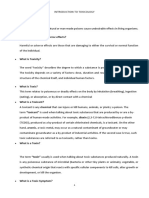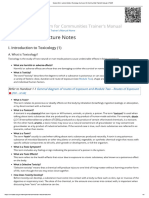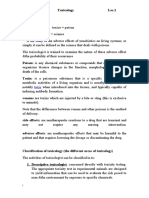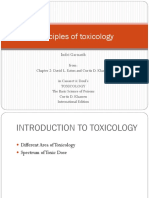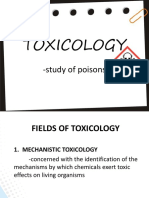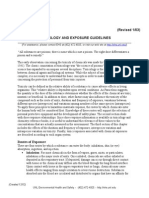Pharma Basic Toxicology
Pharma Basic Toxicology
Uploaded by
CristinaConcepcionCopyright:
Available Formats
Pharma Basic Toxicology
Pharma Basic Toxicology
Uploaded by
CristinaConcepcionOriginal Title
Copyright
Available Formats
Share this document
Did you find this document useful?
Is this content inappropriate?
Copyright:
Available Formats
Pharma Basic Toxicology
Pharma Basic Toxicology
Uploaded by
CristinaConcepcionCopyright:
Available Formats
Subject: Pharmacology Topic: Basic Toxicology Lecturer: Dr.
Laura Aguinaldo Date of Lecture: 06/21/2011 Transcriptionist: Group3 Pages: 8
INSTRUCTIONAL OBJECTIVES To give a brief overview of Toxicology To discuss the general concepts that are important in toxicology To discuss the epidemiology of toxicological cases To discuss the general approach in the management of poisoning To cite the PK/PD of common substances involved in poisoning To give an overview of the various antidotes and their MOA To define and discuss the different toxidromes which are encountered in practice Theophrastus Phillipus Auroleus Bombastus von Hohenheim (1493 1541) a.k.a. PARACELSUS "All things are poison and nothing is without poison; only the dose makes a thing not a poison." This is often condensed to: "The dose makes the poison". TOXICOLOGY the study of the adverse effects of chemical, physical and biological agents on living organisms TOXICITY is the ability of a substance to cause injury to biologic material DEFINITION OF TERMS POISON Any agent that is capable of producing deleterious effect(s) in a biological system, seriously injuring function or producing death. XENOBIOTIC Substance that is not naturally produced within an organism
TOXIN Poisonous substance produced by plants, animals, or bacteria TOXICANT An agent capable of producing symptoms of intoxication or poisoning RISK the potential (likelihood) that injury (biological damage) will occur in a given situation EXPOSURE is the amount of chemical that is available for absorption SAFETY is the probability that harm will not occur under specified conditions (opposite of risk) Specialized fields in Toxicology DESCRIPTIVE TOXICOLOGY involves toxicity testing of chemicals, providing information for safety evaluation and regulatory requirements MECHANISTIC TOXICOLOGY concerned with identifying and understanding mechanisms by which chemicals exert toxic effects on living organisms REGULATORY TOXICOLOGY decides based on the data provided by mechanistic and descriptive toxicology whether a chemical poses risk when marketed to the public FORENSIC TOXICOLOGY concerned primarily with the medico legal aspects of the harmful effects of chemicals on humans and animals CLINICAL TOXICOLOGY Concerned with disease caused by or uniquely associated with toxic substances ENVIRONMENTAL TOXICOLOGY focuses on the impacts of chemical pollutants in the environment on biological organisms
SY 2011-2012
OCCUPATIONAL TOXICOLOGY study of the adverse effects of agents that may be encountered by workers during the course of their employment Toxic Agents may be classified according to: y y y y y y y y Target organ (liver, kidneys, lungs, etc.) Use (industrial solvent,pesticide, food additive Source (plant or animal) Effect (carcinogen, teratogen, liver damage, etc.) Labeling requirements ( flammable, oxidizer, etc) Chemistry (aromatic amine, halogenated hydrocarbon, etc) Biochemical mechanism of action (enzyme inhibitor, binding /damage to biomolecules) Poisoning potential ( practically non-toxic, super toxic)
Subchronic exposure involves repeated daily exposure of the animal to the chemical for 90 days or 3 months Chronic exposure the animal is exposed to the chemical throughout its lifetime: for 2 years in rats and mice, or even longer for dogs and non-human primates Exposure Situation: Frequency Frequency is critical to the concentration levels of the substance in biological fluids/at target site(s); may be expressed as number of exposures/time period Exposure Situation: Route In descending order of effectiveness of toxicity: Parenteral Inhalational Intraperitoneal Intramuscular Subcutaneous Intradermal Oral and Dermal Exposure occurs when any pollutant makes direct contact with an individual via one or more of the possible routes of exposure
Chemical & Physical Properties Physical State: liquid,gas, fume, mist,dust,vapor,etc Solubility: ib biological fluid, water, blood, lipids Vapor pressure >1 mmHg rapid volatilization Vapor density >1 (heavier than air) Reactivity: Chemical and biological Exposure Situation: Duration Acute Exposure is the condition wherein the animal is exposed to a chemical for less than 24 hours usually as a single dose or in divided doses within 13 hours; for the inhalational route, exposure is continuous for 4 hours; effects appear within 14 days Subacute exposure involves repeated daily exposure of the animal to the chemical for less than one month (usually 21 days) by a specific route Exposure Situation: Dosage Dosage (Dose) is the most critical factor in determining whether the intrinsic potential of a substance will be expressed; is the unit of chemical/unit of biological system (mg/unit body weight; mg/body surface area; mL/unit body weight, etc.) Dose-Response (DR) Relationship The most fundamental concept in toxicology Exists when a consistent mathematical relationship describes the proportion of test organisms responding to a specific dose for a given exposure period
Three assumptions: The observed response is due to the agent administered The observed response is due to the dosage administered In using the dose response relationship, one has both a quantifiable method and precise means of measuring toxicity
CHEMICAL INTERACTIONS INDEPENDENT EFFECT substances qualitatively and quantitatively exert their own toxicity independent of each other ADDITIVE EFFECTS the combined effect of exposure to two chemicals is equal to the sum of the effects of exposure to each chemical alone (3+5=8) SYNERGISTIC EFFECTS the combined effect of exposure to two chemicals, given at the same time, is much greater than the sum of the effects of each substance given alone (3+5=30) POTENTIATING EFFECTS one substance, having very low or no toxicity, enhances the expression of toxicity of another (0+5=15) ANTAGONISTIC EFFECTS exposure to two chemicals together interferes with each other s toxic actions ( 4+6=8), or one interferes with the toxic action of the other chemical (4+0=2)
DR curve THRESHOLD the dose at which the first response Is observed
LD50 Midpoint of the curve Estimated dose causing death in 50% of the population under the defined conditions of the test Provides a measure of the toxicity of an agent compared with other agents Other Terms ED50 the dose that produces a desired clinical effect in 50% of the test population NOAEL No observable adverse effect level LOAEL Lowest observable adverse effect level General Classification of Toxic Effects Allergic reactions Idiosyncratic reactions Immediate or acute toxicity Delayed or chronic toxicity Reversible effects Irreversible effects Local toxicity Systemic toxicity
EPIDEMIOLOGY y In the Philippine setting (NPMCC Annual Census 2008) y Total cases: 3,931 Admitted: 1,027 y Telephone referrals: 2,904 y LOCATION: Home in 90% of cases y ROUTE of EXPOSURE: Ingestion in 43.9% of cases y TYPE of EXPOSURE: Acute in 76% of cases y CIRCUMSTANCES of EXPOSURE: Intentional in 53% of cases vs Non-intentional y AGENT INVOLVED: Substances in the home in 58% of cases y AGE CATEGORY : 50% Pediatric age group y SEX y Pediatric Age group M:F = 1: 1.1, y slightly higher in the toddler age group 1.4: 1 y Adult Age Group M:F = 1:1.3 GENERAL APPROACH IN MX OF POISONING CASES 1. Emergency stabilization 2. Clinical evaluation 3. Elimination of the poison 4. Excretion of absorbed substance 5. Administration of antidotes 6. Supportive therapy and observation 7. Disposition 3
Emergency Stabilization y Maintain adequate Airway y Ensure adequate Breathing/ventilation y Maintain adequate Circulation y Treat convulsions (usually with Diazepam) y Correct metabolic abnormalities (Electrolytes, glucose, acid-base) y Treat coma Complete Clinical Evaluation y Good history taking y Complete physical examination Evaluate general status Examine skin Characterize odor of patient s breath Auscultate the lungs Listen to patient s heart Check the abdomen Do a complete neuro exam y Check for toxidromes y Laboratory examinations Information to be Elicited During History Taking y Time of exposure y Mode of exposure y Intake of other substances y Circumstances prior to poisoning y Current medications y Past medical history y Any home remedies taken Elimination of the Poison y External Decontamination y Emptying the stomach Emesis Gastric lavage y Limiting GI absorption Activated charcoal Demulcents/neutralizing agents ***Demulcent at home: egg white Effect: within 30 mins, less damage to the GI Child: atleast 4-6 egg white Adult: 8-12 egg white External Decontamination y Skin and hair decontamination y Whole body bath y Remove all clothing, jewelries, dentures y Mildly alkaline soap (e.g. Perla) y Running water y Drying patient
y y
New clothing Ocular decontamination: sterile NSS
Gastric Lavage y Contraindications: Unprotected Airway, Hydrocarbon or Caustic OD, Esophageal Pathology y Complications: Aspiration Hypoxia, Pneumonia Kinked Orogastric Tube Perforation (Throat, Esophagus, Stomach) Laryngospasm, Epistaxis, Great Discomfort y Should Not Be Routinely Used y No Evidence of Improved Outcome y Serious Complications Occur Rarely y Indication: Life Threatening OD & < 60 Min PI if Asymptomatic > 60 Min PI if Seriously Ill & Intubated Pharmacobezoar on KUB Film
Activated Charcoal y Efficacy Rapidly Over Time y Contraindications: Unprotected Airway, Non Adsorbable Toxin (Metals, Caustics) y Indications: < 1-2 hr post-ingestion, Probable Toxic Amount & Adsorbable (AC) y Dose: 1 Gm/Kg Up To 50 Gm y 10:1 ratio of activated charcoal to xenobiotic
Substances Not Adsorbed by Activated Charcoal y Alcohol y Cyanide y Iron y Lithium y Petroleum distillates (hydrocarbons) -kerosene, diesel, any oil based substance Multiple Dose Activated Charcoal y In conclusion, based on experimental and clinical studies, multiple-dose activated charcoal should be considered only if a patient has ingested a life-threatening amount of carbamazepine, dapsone, phenobarbital, quinine, or theophylline. Position Statement AACT,1999 Current role of Syrup of Ipecac y NOT recommended anymore y AAP recommendation should not be routinely used y Rationale for change: Most poisonings in children are benign Adults who OD usually have rapid mental status deterioration Ipecac induced vomiting may interfere with administration of AC Enhancement of Elimination of Absorbed Substances y **Alkalinization therapy ( urine pH 7-8) Sodium bicarbonate y **Acidification therapy* (urine pH 5-6) Ascorbic acid y Dialysis and hemoperfusion y Multiple dose activated charcoal ** Principle used: Ion Trapping Indications for Dialysis y Amanita phalloides y Antifreeze (glycol type) y Heavy metals in soluble compounds y Heavy metals after chelation y Methanol Indications for Dialysis (Dependent on Patient s Condition) -Alcohols -Ammonia -Amphetamines -Aniline -Barbiturates -Boric acid -Bromides -Calcium
-Chloral hydrate -Ethclorvynol -Iodides -Meprobamate -Potassium -Strychnine -Quinidine -Quinine
-Phenytoin -Fluorides -Isopropanol -Lithium -Paraldehyde -Salicylates -Thiocyanate
Indications for Hemoperfusion y Barbiturates (short and medium acting) y Disopyramide y Gluthetimide y Meprobamate y Phenobarbital y Salicylates y Theophylline Use of Antidotes y Seldom necessary in poisoning Benefit outweighs potential harm Depends on clinical status, or laboratory results y MECHANISMS OF ACTION Inert complex formation Accelerated detoxification Reduction in conversion to more toxic compounds Competitive inhibition at receptor sites Bypassing the effects of the poison Antibody interacting with poison
Inert Complex Formation y Chelating agents Facilitate the formation of a stable complex with the poison, which can be readily excreted y Heavy metal poisoning Lead Arsenic Methylmercury Cadmium Copper y Specific chelating agents DMSA (succimer) dimercapto succinic acid x Arsenic, lead, methylmercury x Cadmium, copper
DMPS dimercapto propane sulphonate x Arsenic, methylmercury Penicillamine x Lead, copper EDTA disodium edetate x Cadmium x Lead BAL British anti-Lewisite x Arsenic NAPA n-acetyl penicillamine x methylmercury Accelerated Detoxification y Enhances formation of a non-toxic or less toxic compound y Na thiosulfate for cyanide poisoning Produce thiocyanate (less toxic) which is readily excreted through the kidneys Reduction in Conversion to More Toxic Compounds y Inhibits formation of metabolites which are more toxic than the parent compound y Ethanol for methanol or ethylene glycol poisoning y Ethanol competes for the same enzyme that metabolizes methanol and ethylene glycol to more toxic compounds Competitive Inhibition at Receptor Sites y Competes for the receptor sites where the poison attaches thereby dislodging it from the receptors y Naloxone for opioid poisoning Blocks opioid receptors in the CNS y Atropine for organophosphate or carbamate poisoning Binds to muscarinic receptors thereby blocking the action of acetylcholine Bypassing the Effect of the Poison y Indirectly counters the effect of the poison y Oxygen for cyanide poisoning Synergestic antidotal action when given with sodium nitrite and sodium thiosulphate y Pyridoxine for INH poisoning Pyridoxine is a needed cofactor for the synthesis of GABA which is depleted in INH poisoning
Antibody Interacting with Poison y Antibody binds to poison rendering in inactive y Digoxin-specific antibody fragments (Digibind) for digitalis poisoning Binds digoxin, limiting the cardiotoxic effects y Cobra antivenom for cobra envenomation -Neutralizes the venom Supportive Therapy y Essential for poisoning patients, especially for critically ill y Problems in the critically ill poisoned patients Depressed sensorium Impaired ventilation Impaired cough reflexes Prone to aspiration Immobility Fluid, electrolyte and other metabolic problems Intravenous fluids: replacement and maintenance Frequent blood and urine pH determination: acidification and alkalinization therapy Prevention of aspiration Prevention of decubitus ulcer Treament of electrolyte, metabolic and temperature problems Monitoring of vital signs Monitoring of input and output Disposition y Observation at the emergency room: at least 24 hours may be warranted y Frequent re-evaluation y Psychiatric evaluation: suicidal patients and substance abusing patients y Childhood poisoning: evaluate for possible child abuse or neglect y Family counselling and education y Physical/sexual abuse among women y Domestic violence Toxidromes y Signs and symptoms which when taken collectively can characterize a suspected toxicant y These groups of manifestations are observed to occur consistently with particular poisons
Seizures + coma + metabolic acidosis = INH (Isoniazid) toxicity
7. Iron - 82
ANTICHOLINERGIC/ANTIDEPRESSANT SYNDROME y y y y y Hyperthermia: Dry mucosa: Flushed skin: Dilated pupils: Confusion/delirium hot as hare dry as a bone red as beet blind as bat mad as a hatter
8. Salicylates - 67
9. Elemental Hg 54
Cholinergic Toxidrome y Diarrhea, diaphoresis y Urination y Miosis, muscle fasciculations y Bradycardia, bronchoconstriction y Emesis y Lacrimation y Salivation Sympathomimetic Toxidrome y Mydriasis y Tachycardia y Hypertension y Hyperthermia y Seizures Narcotic/Opiate Toxidrome y Miosis y Bradycardia y Hypotension y Hypoventilation y Coma Over-All Top Ten Poisoning cases 2008 (N= 3,931) *NPMCC UPCM-PGH 1. Caustics - 442 Acid 91, Alkali 337, Unk - 14
10 Mefenamic Acid 42
CAUSTICS y MOT: Direct corrosive effect; Acid coagulation necrosis; Alkali liquefaction necrosis y Sources of exposure: Household cleaning agents and industrial uses y Treatment: Supportive/ Surgical HEAVY METALS Mercury y MOT: reacts with sulfhydryl groups , resulting in enzyme inhibition and pathologic alteration of the cellular membranes y Sources of exposure: thermometers, bp apparatus & other medical equipments, industrial waste,vaccines (as preservative) y Health Effects: Fine tremors which may progress, neuropsychiatric symptoms, neuropathies, nephropathies, acrodynia y Treatment: Chelation, Hemodialysis Lead y
2. Hydrocarbons - 249 y 3. Alcohol - 243 Household 100 ; Beverage - 143 y y
4. Silver Jewelry Cleaner 226 5. Paracetamol -211
MOT: inactivation and alteration of enzymes and other macromolecules through binding with sulhydryl,phosphate or carboxyl ligands and interaction with cations (Zn, Ca and Fe) Sources of exposure: food, soil, paints, gasoline, industrial sources Health Effects: constitutional effects, GIT, CNS, hematologic, nephropathy, etc Treatment: Chelation, Hemodialysis
6. Pesticides 209
Pyrethroids 112; Carbamates 14 Organophos 46 ; Unknown - 37
Arsenic y MOT: inhibition of enzyme reactions vital to cellular metabolism, oxidative stress, alterations in gene expression y Sources of exposure: Industrial, commercial and pharmaceutical products y Health Effects: GIT, CVS, CNS, Blood, Skin cancer, nail changes ( Aldrich-Mees lines) y Treatment: Chelation, Hemodialysis 7
Paracetamol y Mechanism of toxicity: via CYP2E1 Pathway x Phase 1 reaction x Produces a toxic metabolite which is normally conjugated with GSH to produce the non-toxic mercapturic acid and excreted x NAPQI N-acetyl-pbenzoquinone imine (toxic) x Health Effects: Hepatoxicity y Antidote: N-acetylcysteine (NAC) INH (Isoniazid) y MOT: impairs activity of pyridoxine dependent enzyme systems reducing levels of pyridoxal 5-phosphate interfering with GABA synthesis in the CNS y Health Effects: Metabolic, Cardiovascular, CNS, Hepatotoxic y Antidote: Pyridoxine (Vit. B6) IRON y
Alcohol y MOT: CNS depression, impairment of gluconeogenesis y Health effects: CNS, Hepatotoxicity, CVS, alcohol ketoacidosis, neuropsychiatric y Antidote: Thiamine ( Vit. B1)
_________ End of Transcription __________ Believe in what you re praying for. If God has placed that desire in your Heart, then you must fear not, for HE is with you. Keep the FAITH!!
y y
MOT: Has direct corrosive effects on the GIT. Excessive amounts of absorbed iron can cause cellular dysfuction secondary to oxidative and free-radical injury Health Effects: GI bleeding, Acidosis, Hepatotoxicity, CV abnormalities, CNS Antidote: Deferroxamine
Silver Jewelry Cleaner (Cyanide poisoning) y MOT: a chemical asphyxiant which binds to cellular cytochrome oxidase blocking aerobic utilization of oxygen y Health Effects: GIT, CVS,CNS, rapid DEATH y Sources of Exposure: Industrial i.e. jewelry making and metal plating, laboratory y Antidote: Oxygen, Na Nitrite and Na thiosulfate Salicylates y MOT: Central stimulation of the respiratory center; intracellularly, it can uncouple oxidative phosphorylation interrupting fatty acid and glucose metabolism y Health Effects: Respiratory, CNS, CVS, GIT y Antidote/ Tx: No specific antidote. May be treated with multiple doses of activated charcoal or hemodialysis
You might also like
- Chemical ToxicologyDocument59 pagesChemical ToxicologyMonika Rana100% (1)
- lec1Document38 pageslec1s6x67hsjr9No ratings yet
- Unit 1Document33 pagesUnit 1anjalidhanala45No ratings yet
- Week 14 ToxicologyDocument31 pagesWeek 14 ToxicologyRubenne Miles ElagasNo ratings yet
- Basic Toxicology For MLSDocument20 pagesBasic Toxicology For MLSSimon NyarkoNo ratings yet
- Salud Ocupacional: Universidad El Bosque Facultad Ingeniería AmbientalDocument64 pagesSalud Ocupacional: Universidad El Bosque Facultad Ingeniería AmbientalVALENTINA OVIEDO LEYTONNo ratings yet
- Fundamentals of Toxicology: Sri Hainil, S.Si, M.farm, AptDocument39 pagesFundamentals of Toxicology: Sri Hainil, S.Si, M.farm, AptlyanaNo ratings yet
- Introduction To Toxicology PDFDocument6 pagesIntroduction To Toxicology PDFHaroon rahamatNo ratings yet
- ToxicologyDocument72 pagesToxicologynkosiphendulesopaziNo ratings yet
- Toxicology IDocument30 pagesToxicology IMohamed SHNo ratings yet
- Toxicology For Activists: Romeo F. Quijano, M.DDocument87 pagesToxicology For Activists: Romeo F. Quijano, M.DRomeo QuijanoNo ratings yet
- Toxic o DynamicsDocument6 pagesToxic o DynamicsnkhomaslaterNo ratings yet
- Toxicology 2Document8 pagesToxicology 2KEVIN OMONDINo ratings yet
- Modified IntroductionDocument28 pagesModified IntroductionNormana ZureikatNo ratings yet
- General Principles of ToxicologyDocument8 pagesGeneral Principles of ToxicologyJarot MangkubumiNo ratings yet
- L-16 Toxicity of PesticidesDocument9 pagesL-16 Toxicity of PesticidesMuhammad AhmedNo ratings yet
- Pubdoc 3 1364 6020Document9 pagesPubdoc 3 1364 6020محمدأميندماجNo ratings yet
- Lecture 1-2 Toxicology PDFDocument12 pagesLecture 1-2 Toxicology PDFShah MehboobNo ratings yet
- MSC S 2 Dse 2 U 5Document18 pagesMSC S 2 Dse 2 U 5Kartik SinghNo ratings yet
- T o X I C o L o G yDocument7 pagesT o X I C o L o G yDennis ValdezNo ratings yet
- Principles of ToxicologyDocument24 pagesPrinciples of ToxicologyReo Vebria NINgsihNo ratings yet
- Toksikologi+dose ResponseDocument45 pagesToksikologi+dose ResponseLilik Zakiya100% (2)
- 2015 GMP Validation Forum D2.T2.2.1 Introduction To Toxicology AssessmentDocument71 pages2015 GMP Validation Forum D2.T2.2.1 Introduction To Toxicology AssessmentAshishNo ratings yet
- Casarett and Doull's Toxicology: The Basic Science of Poisons, 4th EditionDocument3 pagesCasarett and Doull's Toxicology: The Basic Science of Poisons, 4th Editionপ্রণয় সাহা প্রান্ময়No ratings yet
- Toxicology 1Document32 pagesToxicology 1Evan Jane GacottNo ratings yet
- Toxicology 01Document15 pagesToxicology 01Jalal Al SayadiNo ratings yet
- ABC T: B D: S OF Oxicology Asic EfinitionsDocument4 pagesABC T: B D: S OF Oxicology Asic EfinitionsLaura ElgarristaNo ratings yet
- ToxicologyDocument5 pagesToxicologys.alisufyaanNo ratings yet
- Toxi Lab 4Document42 pagesToxi Lab 4Zofia RanadaNo ratings yet
- Scope ToxicologyDocument18 pagesScope Toxicologyshubhamatilkar04No ratings yet
- PharmToxicology SampleDocument39 pagesPharmToxicology SampleZulis ChairaniNo ratings yet
- Tox Exposure GuidelinesDocument28 pagesTox Exposure Guidelinesrr48843No ratings yet
- Chapter 1 Introduction of Food Toxicology BBDocument57 pagesChapter 1 Introduction of Food Toxicology BBGiang Thị Thanh HươngNo ratings yet
- 6.0 Adverse Health Effects 6.1 ToxicologyDocument14 pages6.0 Adverse Health Effects 6.1 Toxicologyadelina damayanti putri ismadiNo ratings yet
- Gen Physio Toxi Learning GuideDocument73 pagesGen Physio Toxi Learning GuideColeenkayeCaballeroNo ratings yet
- Tox Exposure GuidelinesDocument10 pagesTox Exposure GuidelinesNova DatukramatNo ratings yet
- Toxicology Written ReportDocument20 pagesToxicology Written Reportanne_ochoaNo ratings yet
- Lecture 1 - Principles of ToxicologyDocument119 pagesLecture 1 - Principles of ToxicologyTae-In LeeNo ratings yet
- Introduction To ToxicologyDocument18 pagesIntroduction To ToxicologyMompati Letsweletse100% (2)
- Introduction To Toxicology 2017 by Dr. PerezDocument15 pagesIntroduction To Toxicology 2017 by Dr. PerezJohn Christopher LucesNo ratings yet
- Regalado ClinTox MT-ET AssignmentDocument3 pagesRegalado ClinTox MT-ET AssignmentKaiNo ratings yet
- Clinical Toxicology-Group 2Document121 pagesClinical Toxicology-Group 2Dan Yel YangcoNo ratings yet
- Basic Concept On Toxicology PDFDocument40 pagesBasic Concept On Toxicology PDFmefav7778520No ratings yet
- Basic Concept On ToxicologyDocument40 pagesBasic Concept On Toxicologyadel santosNo ratings yet
- Detox DrainageDocument56 pagesDetox DrainagethubtendrolmaNo ratings yet
- General ToxicologyDocument57 pagesGeneral ToxicologyOhoodNo ratings yet
- Teacher In-Charge Dr. A. PRAKASH, M.Pharm (Pharmacology), PHD (Nitc)Document34 pagesTeacher In-Charge Dr. A. PRAKASH, M.Pharm (Pharmacology), PHD (Nitc)Prakash AppaNo ratings yet
- Pesticide Poisoning: 1. Disease ReportingDocument4 pagesPesticide Poisoning: 1. Disease ReportingKhaila PutriNo ratings yet
- Toxicology: The Science of PoisonsDocument12 pagesToxicology: The Science of PoisonsTahaa AlHatabNo ratings yet
- Basic Concepts in Toxicology - FDocument90 pagesBasic Concepts in Toxicology - FKhokonNo ratings yet
- 1 Principles of Toxicology PDFDocument85 pages1 Principles of Toxicology PDFMariefe BlayaNo ratings yet
- Env TocicologyDocument38 pagesEnv Tocicologyaneeqahmadaa2018No ratings yet
- General Principles of ToxicologyDocument23 pagesGeneral Principles of ToxicologyHabib DawarNo ratings yet
- Principle of Toxicology: Dose Response Relationship Comparison of Dose ResponseDocument19 pagesPrinciple of Toxicology: Dose Response Relationship Comparison of Dose ResponseUrugonda VenumadhavNo ratings yet
- Determination of Toxicants in Foods 2Document34 pagesDetermination of Toxicants in Foods 2carson_kress3596100% (2)
- New Drug DevelopmentDocument69 pagesNew Drug DevelopmentEmaan NoorNo ratings yet
- Toxicological ScreeningDocument11 pagesToxicological Screeningkunalprabhu148100% (1)
- Drug-Induced Oral ComplicationsFrom EverandDrug-Induced Oral ComplicationsSarah CoustyNo ratings yet
- 2011 07 Microbiology Mycobacterium Skin InfectionDocument6 pages2011 07 Microbiology Mycobacterium Skin InfectionCristinaConcepcionNo ratings yet
- Approach To Patient With Allergic Diseases: Jovilia M. Abong, M.D. FPCP, Fpsaai, MSCDocument65 pagesApproach To Patient With Allergic Diseases: Jovilia M. Abong, M.D. FPCP, Fpsaai, MSCCristinaConcepcionNo ratings yet
- 2011 087 Microbiology Intro To Mycology FinalDocument7 pages2011 087 Microbiology Intro To Mycology FinalCristinaConcepcionNo ratings yet
- 2011 07 MICROBIO LAST PAGE of Bacterial Skin Infection 2Document1 page2011 07 MICROBIO LAST PAGE of Bacterial Skin Infection 2CristinaConcepcionNo ratings yet
- 2 - Inflammation and Repair (Edited Ver)Document149 pages2 - Inflammation and Repair (Edited Ver)CristinaConcepcionNo ratings yet
- Lect Notes - Bacterial Genetics 2012-2013Document10 pagesLect Notes - Bacterial Genetics 2012-2013CristinaConcepcionNo ratings yet
- BeneficenceDocument31 pagesBeneficenceCristinaConcepcion100% (1)







